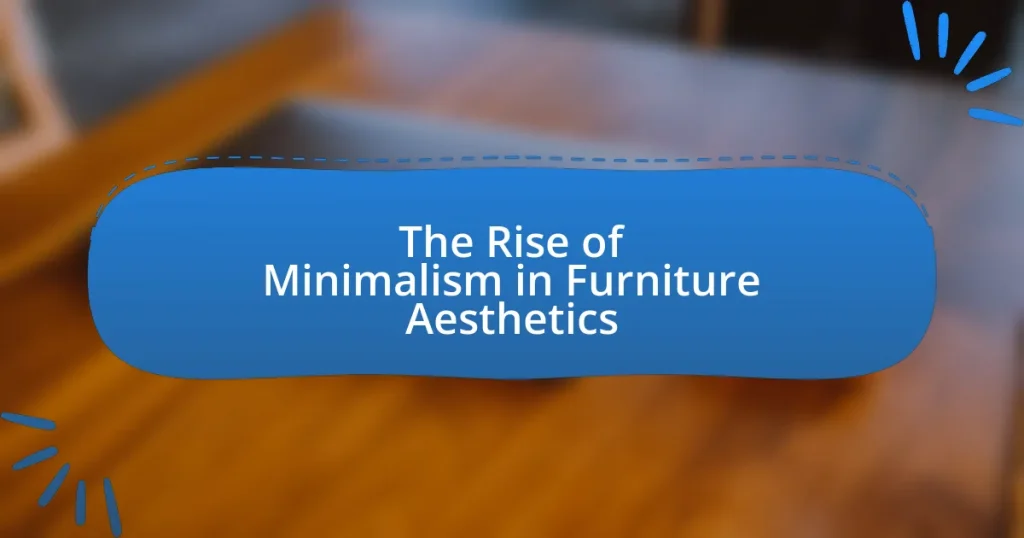Minimalism in furniture aesthetics is a design philosophy that emphasizes simplicity, functionality, and the elimination of excess, characterized by clean lines, neutral colors, and uncluttered spaces. Emerging in the mid-20th century as a reaction against ornate styles, it draws influences from movements such as Bauhaus, De Stijl, and Japanese aesthetics. The article explores the historical context of Minimalism, its key characteristics, and the materials commonly used in minimalist furniture design. It also addresses the societal trends contributing to its popularity, the impact of technology and sustainability on future designs, and practical tips for implementing and maintaining a minimalist aesthetic in living spaces.

What is Minimalism in Furniture Aesthetics?
Minimalism in furniture aesthetics is a design philosophy that emphasizes simplicity, functionality, and the elimination of excess. This approach prioritizes clean lines, neutral colors, and uncluttered spaces, allowing the beauty of the materials and craftsmanship to stand out. Minimalism originated in the mid-20th century as a reaction against ornate and elaborate styles, with notable influences from Japanese design principles that value simplicity and natural materials. The effectiveness of minimalism is evidenced by its enduring popularity in contemporary design, where it is often associated with creating serene and harmonious living environments.
How did Minimalism emerge as a design philosophy?
Minimalism emerged as a design philosophy in the mid-20th century, primarily as a reaction against the ornate styles of previous design movements. Influenced by the Bauhaus and De Stijl movements, Minimalism emphasized simplicity, functionality, and the reduction of form to its essential elements. This approach was further popularized in the 1960s and 1970s by artists and designers such as Donald Judd and Agnes Martin, who sought to strip away unnecessary details and focus on the purity of materials and shapes. The minimalist aesthetic gained traction in various fields, including architecture and furniture design, as it aligned with the modernist ideals of clarity and efficiency.
What historical movements influenced Minimalism in furniture design?
Minimalism in furniture design was influenced by several historical movements, primarily the Bauhaus, De Stijl, and Japanese aesthetics. The Bauhaus movement, founded in Germany in 1919, emphasized functional design and the unity of art and technology, promoting simplicity and the elimination of unnecessary ornamentation. De Stijl, emerging in the Netherlands in the early 20th century, advocated for abstraction and geometric forms, which directly contributed to the minimalist ethos of reducing design to its essential elements. Additionally, Japanese aesthetics, particularly the principles of wabi-sabi, emphasized simplicity, natural materials, and the beauty of imperfection, further shaping minimalist design principles. These movements collectively laid the groundwork for the minimalist approach, prioritizing functionality and simplicity in furniture design.
How does Minimalism differ from other design styles?
Minimalism differs from other design styles by emphasizing simplicity and functionality, stripping away excess ornamentation to focus on essential elements. Unlike ornate styles such as Baroque or Rococo, which prioritize decorative details, Minimalism champions clean lines, open spaces, and a limited color palette. This approach is rooted in the belief that less is more, promoting a sense of calm and clarity in design. Historical context shows that Minimalism emerged in the mid-20th century as a reaction against the complexity of previous styles, aligning with movements in art and architecture that sought to reduce forms to their most basic components.
What are the key characteristics of Minimalist furniture?
Minimalist furniture is characterized by simplicity, functionality, and a lack of ornamentation. This design style emphasizes clean lines, neutral colors, and open spaces, creating an uncluttered aesthetic. The focus is on essential forms and materials, often utilizing natural elements like wood and metal, which enhances the overall functionality and durability of the pieces. Minimalist furniture often features multi-functional designs, allowing for efficient use of space, which is particularly beneficial in smaller living environments. The principles of minimalism are rooted in the idea that less is more, promoting a lifestyle that values quality over quantity.
What materials are commonly used in Minimalist furniture design?
Common materials used in Minimalist furniture design include wood, metal, glass, and plastic. Wood, particularly in its natural form, provides warmth and simplicity, while metal offers durability and a sleek aesthetic. Glass is often utilized for its transparency, creating an illusion of space, and plastic is favored for its versatility and ease of maintenance. These materials align with the principles of Minimalism, emphasizing functionality and clean lines, which are essential for creating uncluttered and harmonious living environments.
How does color play a role in Minimalist aesthetics?
Color in Minimalist aesthetics serves to enhance simplicity and focus, often utilizing a limited palette to create a sense of calm and clarity. This approach emphasizes neutral tones, such as whites, grays, and beiges, which contribute to an uncluttered visual experience. Research indicates that these colors can evoke feelings of tranquility and spaciousness, aligning with the core principles of Minimalism that prioritize functionality and the elimination of excess. For instance, a study published in the Journal of Environmental Psychology found that environments with neutral color schemes can significantly reduce stress levels, reinforcing the effectiveness of color in achieving the desired aesthetic and emotional impact in Minimalist design.
Why has Minimalism gained popularity in recent years?
Minimalism has gained popularity in recent years due to a growing desire for simplicity and intentional living. This shift is largely influenced by the overwhelming nature of consumer culture and the digital age, where individuals seek to declutter their lives both physically and mentally. Research indicates that minimalism can lead to reduced stress and increased focus, as evidenced by studies showing that a simplified environment enhances productivity and well-being. Additionally, the rise of social media platforms has facilitated the sharing of minimalist lifestyles, further promoting its appeal among younger generations who value experiences over material possessions.
What societal trends contribute to the rise of Minimalism?
The rise of Minimalism is primarily driven by societal trends such as consumerism backlash, environmental awareness, and the digital age’s influence on lifestyle choices. Consumerism backlash reflects a growing discontent with material excess, prompting individuals to seek simplicity and intentional living. Environmental awareness has led many to prioritize sustainability, favoring minimalistic designs that reduce waste and promote eco-friendly practices. Additionally, the digital age fosters a culture of decluttering, as people increasingly value experiences over possessions, aligning with Minimalism’s core principles. These trends collectively validate Minimalism’s appeal in contemporary society.
How does Minimalism address modern consumerism?
Minimalism addresses modern consumerism by promoting the idea of reducing excess and focusing on essential items, which counters the culture of overconsumption. This philosophy encourages individuals to prioritize quality over quantity, leading to more thoughtful purchasing decisions. Research indicates that minimalism can reduce stress and increase satisfaction, as seen in studies like “The Impact of Minimalism on Consumer Behavior” by authors from the Journal of Consumer Research, which highlights how minimalism fosters a more intentional relationship with possessions. By advocating for simplicity, minimalism challenges the relentless pursuit of material goods that characterizes contemporary consumerism.
How does Minimalism impact interior design?
Minimalism significantly impacts interior design by promoting simplicity, functionality, and a decluttered aesthetic. This design philosophy emphasizes the use of essential elements, reducing excess ornamentation and focusing on clean lines and open spaces. Research indicates that minimalist interiors can enhance mental well-being by creating a calming environment, as supported by studies showing that clutter can lead to increased stress levels. Furthermore, minimalism encourages the use of sustainable materials and multifunctional furniture, aligning with contemporary trends towards eco-friendliness and efficient living.
What are the benefits of incorporating Minimalist furniture in home decor?
Incorporating minimalist furniture in home decor offers several benefits, including enhanced space efficiency and a calming aesthetic. Minimalist furniture typically features clean lines and a lack of clutter, which can make small spaces feel larger and more open. Research indicates that environments with less visual clutter can reduce stress and improve focus, as supported by a study published in the Journal of Environmental Psychology, which found that simplified spaces contribute to better mental well-being. Additionally, minimalist furniture often emphasizes functionality, allowing for versatile use and easier maintenance, which aligns with contemporary lifestyle needs.
How can Minimalism enhance the functionality of a space?
Minimalism enhances the functionality of a space by prioritizing essential elements and eliminating unnecessary clutter. This approach allows for better organization and accessibility, making it easier to navigate and utilize the space effectively. For instance, studies show that minimalist designs can improve focus and productivity by reducing distractions, as seen in various work environments where streamlined furniture and layouts promote efficiency. Additionally, minimalism often incorporates multifunctional furniture, which maximizes utility without overcrowding the area, further supporting the efficient use of space.

What are the challenges of adopting Minimalism in furniture aesthetics?
Adopting Minimalism in furniture aesthetics presents several challenges, including the difficulty of achieving a balance between functionality and simplicity. Minimalist design often requires careful selection of pieces that serve multiple purposes, which can limit options and complicate the decision-making process. Additionally, the emphasis on clean lines and open spaces can lead to a perception of coldness or sterility, making it challenging to create a warm and inviting atmosphere. Furthermore, the financial investment in high-quality minimalist furniture can be significant, as cheaper alternatives may not provide the desired aesthetic or durability. These factors collectively contribute to the complexities of embracing Minimalism in furniture design.
What misconceptions exist about Minimalist furniture?
One misconception about minimalist furniture is that it is uncomfortable or impractical. Many people believe that the focus on simplicity and clean lines sacrifices comfort and functionality. However, minimalist furniture is designed with ergonomics in mind, often using high-quality materials that provide both aesthetic appeal and comfort. For instance, Scandinavian design, a prominent influence in minimalism, emphasizes both form and function, ensuring that pieces like chairs and sofas are not only visually pleasing but also supportive and usable in everyday life.
How can one overcome the fear of emptiness in Minimalist spaces?
To overcome the fear of emptiness in minimalist spaces, one can focus on intentional design choices that create a sense of warmth and purpose. Incorporating elements such as strategically placed artwork, plants, or textured fabrics can add visual interest and comfort without cluttering the space. Research indicates that environments with a balance of open space and personal touches can enhance feelings of well-being and reduce anxiety associated with emptiness. For instance, a study published in the Journal of Environmental Psychology found that well-designed minimalist spaces can promote relaxation and clarity of thought, demonstrating that minimalism does not equate to sterility but can foster a serene atmosphere.
What are common pitfalls when transitioning to a Minimalist aesthetic?
Common pitfalls when transitioning to a Minimalist aesthetic include over-purging belongings, which can lead to regret and a lack of essential items. Many individuals mistakenly believe that minimalism requires eliminating all personal items, resulting in spaces that feel sterile and uninviting. Additionally, failing to establish a clear vision of what minimalism means for one’s lifestyle can lead to inconsistent choices and clutter. Research indicates that a lack of planning often results in reverting to previous habits, as individuals may not fully understand the principles of minimalism. Lastly, underestimating the emotional attachment to items can hinder the transition, as people may struggle to let go of possessions that hold sentimental value.
How can individuals avoid clutter while embracing Minimalism?
Individuals can avoid clutter while embracing Minimalism by adopting a “one in, one out” policy, which ensures that for every new item brought into the home, an existing item is removed. This practice helps maintain a balanced environment and prevents accumulation of unnecessary possessions. Research indicates that minimalism can lead to reduced stress and increased focus, as a clutter-free space promotes mental clarity. A study published in the Journal of Environmental Psychology found that individuals in organized environments reported higher levels of well-being and lower levels of anxiety. By consistently evaluating the necessity of items and prioritizing quality over quantity, individuals can effectively maintain a minimalist lifestyle while avoiding clutter.

What are the future trends in Minimalist furniture design?
Future trends in minimalist furniture design include sustainable materials, multifunctional pieces, and smart technology integration. As consumers increasingly prioritize eco-friendliness, designers are focusing on using recycled and renewable materials, which aligns with the growing demand for sustainability in home furnishings. Additionally, the trend towards multifunctional furniture, such as sofas that convert into beds or tables with built-in storage, reflects the need for efficient use of space in smaller living environments. Furthermore, the incorporation of smart technology, like adjustable lighting and integrated charging stations, enhances functionality while maintaining a clean aesthetic. These trends are supported by market research indicating a significant rise in consumer interest in sustainable and multifunctional designs, as well as the increasing prevalence of smart home technology.
How is technology influencing Minimalist furniture aesthetics?
Technology is significantly influencing Minimalist furniture aesthetics by enabling the creation of sleek, functional designs that prioritize simplicity and efficiency. Advanced manufacturing techniques, such as CNC machining and 3D printing, allow for precise, clean lines and innovative shapes that embody minimalist principles. Additionally, the use of sustainable materials and smart technology integration, like modular components and multifunctional furniture, enhances the minimalist ethos of reducing clutter while maximizing utility. For instance, companies like IKEA utilize digital design tools to streamline production and offer customizable minimalist options, reflecting a growing trend towards minimalism in contemporary furniture design.
What role do sustainable practices play in future Minimalist designs?
Sustainable practices are integral to future Minimalist designs as they prioritize resource efficiency and environmental responsibility. By utilizing eco-friendly materials and production methods, designers can create furniture that minimizes waste and reduces carbon footprints. For instance, the use of reclaimed wood and recycled metals not only aligns with Minimalist aesthetics but also supports sustainability goals. Furthermore, studies indicate that consumers increasingly prefer products that reflect ethical considerations, with a 2021 survey showing that 66% of global consumers are willing to pay more for sustainable brands. This shift in consumer behavior reinforces the necessity for Minimalist designs to incorporate sustainable practices, ensuring they remain relevant and appealing in the evolving market.
What are some practical tips for implementing Minimalism in furniture choices?
To implement Minimalism in furniture choices, prioritize multifunctional pieces that serve more than one purpose, such as a sofa bed or an ottoman with storage. This approach reduces clutter and maximizes utility, aligning with Minimalism’s core principle of simplicity. Additionally, select furniture with clean lines and neutral colors to create a cohesive and serene environment, as studies show that such designs promote a sense of calm and order. Finally, limit the number of items in each room to only those that are essential or bring joy, which is a key tenet of Minimalism, ensuring that each piece contributes meaningfully to the space.
How can one curate a Minimalist furniture collection effectively?
To curate a Minimalist furniture collection effectively, one should focus on selecting essential pieces that emphasize simplicity and functionality. This involves evaluating each item for its utility, aesthetic appeal, and ability to harmonize with the overall space. Research indicates that Minimalism promotes a decluttered environment, which can enhance mental clarity and well-being, as supported by studies from the Journal of Environmental Psychology. Prioritize high-quality materials and timeless designs that withstand trends, ensuring longevity and sustainability in the collection.
What are the best practices for maintaining a Minimalist aesthetic in living spaces?
To maintain a Minimalist aesthetic in living spaces, prioritize simplicity by selecting essential furniture and decor that serve a purpose without excess. This approach emphasizes clean lines, neutral color palettes, and uncluttered surfaces, which contribute to a serene environment. Research indicates that minimalism can enhance mental clarity and reduce stress, as supported by studies showing that clutter negatively impacts focus and well-being. By regularly decluttering and only keeping items that add value or joy, individuals can sustain a minimalist aesthetic effectively.


